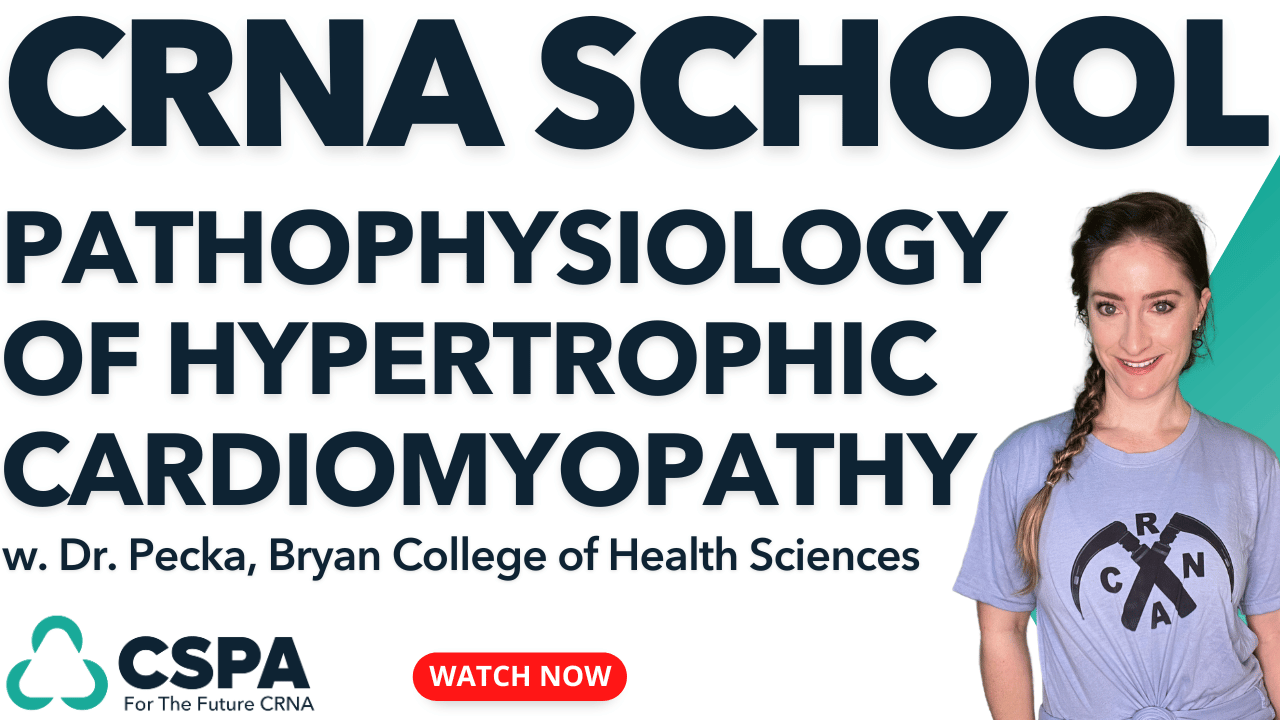
Get Your FREE Norepinephrine Study Notes
https://www.cspaedu.com/Norepinephrine
Norepinephrine is a naturally occurring chemical in the body that acts both as a hormone and a neurotransmitter. Since it is one of the most frequently used drugs in ICUs, expect to be asked about it during CRNA school interviews. Jenny Finnell is here to break down norepinephrine, talking about its major uses and how it is terminated within the body. She also details its mechanism of action at a cellular level and offers a free study guide to help you with your application prep.
Thousands of nurses have gained CRNA school acceptance with CRNA School Prep Academy. Join today for access to all of the tools proven to accelerate your CRNA success! Click here:
https://crnaschoolprepacademy.com/join
Join the CSPA email list: https://www.cspaedu.com/podcast-email
Join the Free Facebook Community here! https://www.facebook.com/groups/crnaschoolprepacademyfree
Book a mock interview, resume or personal statement critique, transcript review and more: www.teachrn.com
—
Watch the episode here
Listen to the podcast here
Norepinephrine: What Is It And How Does It Work?
In this episode, we’re going to break down norepinephrine. This drug is a drug that you will use very frequently in the ICU. It is also a common drug that is asked during CRNA school interviews. We’re going to deep dive into this drug today and it’s going to be a new teaching style. If you’re watching this on YouTube, I hope you enjoy it. I would love to hear your feedback on that. Also, because I don’t want you to have to worry about missing anything, I have provided a PDF version of the notes, whether that’s on YouTube or the show. You should have access to grab the notes.
Understanding Norepinephrine (Levophed)
As we break down norepinephrine, I want to point out that this comes or you should be familiar with other names for this drug, the generic name and trade name. Norepinephrine is Levophed. You also have noradrenaline and some people call it norepi. That’s probably what I refer to it the most. It’s easier to say and it’s more fun to say it that way too. What is norepi? Norepi is a naturally occurring chemical and the body that acts as both a hormone and a neurotransmitter.
When it’s given as an IV medication, we can reproduce these effects. It’s also considered a sympathomimetic medication, which essentially means that it can mimic the effects of a hormone on the sympathetic nervous system. When we use it, we use it primarily as a vasopressor to increase blood pressure. It increases blood pressure, your SVR, and your PVR. It increases your wedge pressure, your MAP or your Mean Arterial Pressure, your CVP or Central Venous Pressure, your heart rate, and cardiac output.
One thing to keep in mind when using norepinephrine or norepi is that you can cause tachycardia with this drug, especially at higher doses, and the tachycardia can decrease your cardiac output due to the decreased time spent in diastole. Now, if you have someone who has a healthy compliant heart, it’s not as big of a deal, but if you’re dealing with someone who has a hypertrophic heart or valvular dysfunction of some kind, tachycardia could be incredibly significant for them as far as increasing their oxygen demands on their body and potentially sitting up for cardiac ischemia. You want to be very careful when choosing this drug that you’re choosing it for the right patient.
How does norepi work? Norepi activates adrenergic receptors of the sympathetic nervous system. It’s an endogenous hormone that is found in our bodies. We give it via medication to mimic these effects. Adrenergic receptors stimulated by norepi include alpha-1, alpha-2, beta-1, and very little beta-2. Again, we’re looking at mostly alpha-1 alpha-2, beta-1, and again, very little effects on beta-2. Alpha-1 is where the majority of the effects come in from norepi.
Alpha-1 is what causes that smooth muscle contraction of both the arterials and the veins equally, which then leads to vasoconstriction or an increase in SVR and increased blood pressure. Now, alpha-2 inhibits further release of norepinephrine and serves as a mechanism of negative feedback. That’s what alpha-2 does. Again, we mentioned both of them because it does stimulate both. However, alpha-2 is not where the mechanism of action unfolds. It’s more on the alpha-1.
Now, beta-1 primarily affects the heart and beta-1 is where you get the tachycardic effects from increased doses of norepinephrine. Beta-1 causes an increase in heart rate, which is also known as a positive chronotropic effect, and an increase in contractility, which is a positive inotropic effect. Increased heart rate is a positive chronotropic effect and increased contractility is a positive inotropic effect.
I would highly encourage you to use these terms when speaking about this drug, especially in the interview setting. It sounds a lot more informed than saying increases heart rate or increases contractility. Saying these key terms can highlight the advanced knowledge that you have about the mechanism of action of these drugs. Between the positive chronotropic effect and inotropic effect, it leads to an increase in cardiac output.
In your CRNA interview, use terms like positive chronotropic effect and positive inotropic. This will make you sound more informed than just saying increased heart rate and increased contractility. Share on XAs I spoke to before, there’s little effect on the Beta-2 receptors. Beta-2 receptors, however, do cause smooth muscle relaxation and ultimately, bronchial dilatation. It also dilates arteries of the skeletal muscle, hence your bronchioles, coronary, and hepatic arteries. That again is beta-2. If you think about Beta-1 being you have one heart and beta-2, you have two lungs. That’s an easy way to remember beta-1 and Beta-2 if you haven’t got that down yet. Think of Beta-2 again causes bronchodilation or the relaxation of smooth muscle.
The affinity to bind to receptors is affected by concentration, temperature, and pH. Therefore, when your patient is circling the toilet and getting more acidotic, you’re going to see that you’re going to have to titrate up on the Levophed and that is why. Again, temperature plays into account, pH as well as concentration of the drug.
Release and Metabolism
Let’s get into the release and metabolism at this point. The release comes from the cells called the chromaffin cells. The chromaffin cells, between norepinephrine and epinephrine, are released from these cells within the adrenal medulla in proportions of approximately 20% to 80%. It means 20% norepi and 80% epinephrine. Your body primarily releases epinephrine at 80% and norepinephrine at 20%.
The chromaffin cells are located in the adrenal medulla, and then again they synthesize and release catecholamines such as epinephrine, norepinephrine, and dopamine. That is chromaffin cells. That is where your norepinephrine is released, which is inside of the adrenal medulla. Now, let’s get into the metabolism of norepinephrine. There is the enzyme MAO-A, which is monoamine oxidase-A in the nerve terminals that helps metabolize norepinephrine. You also have Catechol-O-Methyltransferase. The abbreviation is COMT in the liver and plasma.
Again, these are primarily responsible for the metabolism of norepinephrine. For sure, it’s MAO-A and COMT. These are the two different types of enzymes that break down norepinephrine. You also have the termination of norepinephrine, which first starts with the diffusion of norepinephrine away from the adrenergic receptor. The very first step to terminate norepinephrine from action is the diffusion of norepinephrine away from the adrenergic receptor.
The termination mechanism is that the re-uptake is the process that terminates 80% of the effects of norepinephrine. You may be wondering what a is re-uptake, Jenny. Re-uptake is essentially the reabsorption of a neurotransmitter transporter located along the plasma membrane of an axon terminal or a glial cell after it has performed its function of transmitting the neural impulse. That is what re-uptake is, and that is what is responsible for 80% of the termination of norepinephrine. Again, you have your metabolism, which we already went over, which is the MAO-A as well as the COMT that again breaks down this drug both in the blood and in the liver. This is where the metabolism between those enzymes occurs.
Lastly, you have the diffusion away from the receptors. Let’s go over that again. You have the metabolism of norepinephrine with the breakdown of enzymes such as the MAO-A or the COMT. You have the diffusion away from the receptor sites and the biggest one is the re-uptake, which accounts for 80% of its termination. That is how norepinephrine is broken down and terminated within your body.
Norepinephrine Mechanism of Action
Now, we’re going to get into the mechanism of action at a cellular level. Let’s go into that next. First, you have the receptor binding. When the receptor or norepinephrine binds to alpha-1 adrenergic receptors, it triggers a cascade of intracellular events. This binding activates the G-protein coupled receptor pathways leading to the activation of phospholipase C or PLC. You also have the secondary messengers, which is when the phospholipase C then catalyzes the conversion of what we call PIP2 into two secondary messengers IP3 and DAG.
Secondary messengers such as phospholipase C catalyzes the conversion of PIP2 into two secondary messengers, IP3 and DAG. Then third, you have the calcium mobilization. Calcium mobilization is where the magic starts to happen. IP three stimulates the release of calcium ions from the sarcoplasmic reticulum into the cytoplasm. The increase in sarcoplasmic calcium concentration is crucial for muscle contraction. In vascular smooth muscle cells, calcium binds to calmodulin activating myosin light-chain kinase abbreviated as MLCK. It stands for Myosin Light-Chain Kinase.
Finally, you have your muscle contraction. The myosin light-chain kinase or the MLCK phosphorylates light chains in the myosin heads allowing the myosin heads to interact with actin filaments leading to contraction. When we’re talking about vasopressors, we’re looking at vascular smooth muscle. This contraction results in the vasoconstriction that we achieve by giving the vasopressor.
Let me cover that one more time because that was a lot of heavy information. I want to do another brief quick overview. The mechanism of action is down to the cellular level of norepinephrine. First, you have the receptor binding again, which is where your alpha-1 adrenergic receptors and all your adrenergic receptors trigger a cascade of intracellular events such as G-protein coupled receptor pathways, which then lead to the activation of PLC or phospholipase C. The phospholipase C catalyzes the conversion of PIP2 into secondary messengers such as IP3 and DAG.
You then have the calcium mobilization, which is where the IP3 stimulates the release of calcium ions into the sarcoplasmic reticulum and then into the cytoplasm. This increased cytoplasmic calcium concentration is crucial for muscle contraction, which ultimately leads to the myosin light-chain kinase activation, which then further causes smooth muscle contraction or vasoconstriction.
Dosing Tips
That is down to the cellular level. It is all written for you clear as day in your PDF notes that you can get. Now, we’re going to wrap this up with some norepinephrone dosing and then we’re going to cover some common uses. Finally, I’m going to go over some formulas that I feel you should make sure you know. Important things to know about dosing is that the half-life is two and a half minutes. Also, when you do a continuous infusion, you achieve a steady-state plasma concentration.
You can mix Levophed in various concentrations. You can do 4 milligrams, 8 milligrams, 16 milligrams, or 32 milligrams in a 250 ml bag. You’ll see it at all different types of concentrations. How many mics per ML would each of these concentrations make? I’m going to challenge you to think through that. I’m going to teach you a trick if you don’t already know it. It makes this easy and it only works for 250 so don’t get too excited.
For any drug that you put into a 250 ml bag to get the mics per ml, all you need to do is simply multiply the milligrams by four. If you have 4 milligrams in 250, you take four times four, which is 16 mics per ml. If you have 8 milligrams and two 50, you times that by four and get 32 mics per ml. 16, you get 64 mics per ml, 32 milligrams and 250, you get 128 mics per ml, and so on and so on. Anything in 250 allows a very simple conversion into mics per ml. If you’re giving this as an IV infusion, you’re looking at 1 to 30 mics per minute or 0.02 mics per kilo per minute up to 1 mic per kilo per minute.
The way you give this medication is going to vary from facility to facility. Make sure you understand the protocols at your facility or why you’re using the medication. What’s your use case for it? One benefit of using it at low doses is the fact that you have less tachycardia. Again, at higher doses, you will get tachycardia along with it.
Some common uses for norepinephrine include hypotension and shock. It’s primarily used for the vasoconstriction. Alpha-1 and Beta-1 and increases SVR, which increases your blood pressure and MAP. It’s most commonly used for distributive shock, which is sepsis. Cardiogenic shock may be counterintuitive due to the increase in afterload. It will make the heart failure worse. Lastly, we’re going to get into some formulas. I feel like you guys should know your SVR, which is 80 times MAP minus CVP divided by cardiac output.
Again, your systemic vascular resistance, normal levels are 900 to 1,200 per second. That’s peripheral vascular resistance and SVR. Next, we’re going to move on to some cardiac formulas that I think you should make note of, which is cardiac output, which is stroke volume times heart rate. It may seem basic, but this is a common question that could be asked in interviews. Also, what is stroke volume?

Norepinephrine: Make note which is the cardiac output and stroke volume times heart rate. This may seem basic, but it is a common question in CRNA interviews.
It means, “What’s the formula for stroke volume?” You should know the average stroke volume. The normal is about 70 mls. Again, stroke volume, how to figure that out. It’s the end-diastolic volume minus the end-systolic volume. Lastly, what is the ejection fraction or the EF? This is your stroke volume divided by your end-diastolic volume.
The EF again is your stroke volume divided by your end-diastolic volume. That is your ejection fraction. I hope you guys enjoyed this episode. Best of luck to you. I hope you feel more comfortable with norepinephrine. We’re going to do epinephrine next, and then we’re going to go into neo. I’m excited to share these other drugs with you. Take care.
Important Links
Get Your FREE Norepinephrine Study Notes: https://www.cspaedu.com/Norepinephrine
FREE! CRNA School Interview Prep Guide: https://www.cspaedu.com/irptwqbx
Thousands of nurses have gained CRNA school acceptance with CRNA School Prep Academy. Join today for access to all of the tools proven to accelerate your CRNA success! Click here:
https://crnaschoolprepacademy.com/join
Join the CSPA email list: https://www.cspaedu.com/podcast-email
Join the Free Facebook Community here! https://www.facebook.com/groups/crnaschoolprepacademyfree
Book a mock interview, resume or personal statement critique, transcript review and more: www.teachrn.com









